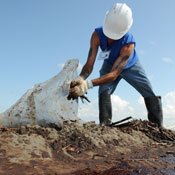Gulfport Councilman Kenneth Casey said he fears the oncoming hurricane season and what it could mean to the waters and shoreline of the Mississippi Gulf Coast.
"If the weather stays like it is and we don't get any kind of tropical disturbance, we might be OK for now," Casey said. "(A hurricane) will be working against us because it'll push the oil on in."
Mississippi's coast remains relatively calm and oil free, even though oil spouting from the April 20 destruction of a British Petroleum deepwater oil well is devastating Louisiana wetlands. Tourists combing the beaches of Gulfport won't catch many indications of oil in the water.
Gov. Haley Barbour reiterated what he said Sunday on a FOX News interview to House members on Tuesday during a committee hearing on the oil spill. Barbour said the coast is clear, and urged tourists not to rule out the Mississippi Gulf Coast as a destination in the midst of the historic geyser of oil
40 miles off the coast of Louisiana.
Barbour also said that the national media is doing more damage to the Mississippi tourism industry than the oil by broadcasting pictures of oil damage in nearby Louisiana and giving viewers the impression that the Mississippi coast is "ankle-deep" in oil.
Despite Barbour's assurances, some House members left the Tuesday hearing without knowing the potential risk of dispersants British Petroleum is using to break up and sink millions of gallons of oil.
Frances Fredericks, D-Gulfport, chairman the House Marine Resources Committee, said Barbour, the Mississippi Emergency Management Agency and the Mississippi Department of Environmental Quality gave her no straight answers on the potential long-term toxicity of the dispersant Corexit, which BP has for weeks dumped on the ocean surface and injected directly in to the erupting well. BP reported on June 4 that it had used more than 1 million gallons of the dispersant, and had 450,000 gallons still available.
Barbour downplayed the potential problems of using the dispersant, which increases in toxicity when mixed with oil, according to EPA tests on the chemical. He said some of the ingredients inside the dispersant can be found in most households, but Fredericks countered, saying she doesn't drink many of the chemicals stored in her house for a reason.
Casey agreed with Barbour's assessment of a clean Mississippi coast, but said he suspected the oil was further underwater and out to sea, and that even a modest seasonal storm could bring the oil ashore. "A lot of the oil is underwater, but (a storm) could push it up onto the beaches, and this is hurricane season," he said.
The U.S. Geological Survey agrees, particularly when it comes to the vulnerability of Mississippi's barrier islands. USGS predicts that a tropical storm could almost completely inundate Mississippi's Ship Island and cover it with destructive oil-infused water. Douglas N. Rader, chief ocean scientist with the Environmental Defense Fund, said the oil is out in the water wreaking damage, even without the help of a storm, and that hydrocarbon toxins are likely winding their way into the oceanic food chain.
Mississippi Emergency Management Agency Executive Director Mike Womack told House members that the Environmental Protection Agency and MEMA is diligently testing state waters for traces of the dispersant and oil, and declared state waters free of toxins on Tuesday, even though the National Oceanic and Atmospheric Agency banned fishing from federal waters less than 30 miles from the Mississippi coast.
In the meantime, oil continues to spew out of the "capped" well. BP announced Monday that its "lower marine riser package (LMRP) containment cap," which the company installed June 3, "continues to collect oil and gas flowing from the well and transport them to the Discoverer Enterprise drillship on the surface." BP said it had collected "a total of 10,500 barrels of oil" (441,000 gallons) with only one of the cap's four vents closed and burned off 22 million standard cubic feet of natural gas. From June 3 through June 5, the company reported that it collected 16,600 barrels of oil—a drop in the bucket compared to most estimates of the oil rushing into the Gulf from the mile-deep underwater well.
Estimates of how much oil is going into the Gulf vary widely, with no estimates of what percentage the cap is allowing BP to collect. The U.S. Geological Survey estimated May 27 that 504,000 gallons of oil a day are spilling directly into Gulf waters, a disputed best-case scenario. Public Broadcasting Service reports that BP's worst-case estimate is that slightly more than 1 million gallons a day are escaping the well. Experts outside of BP predict—as a possible worst-case scenario—that more than 4 million gallons of oil are erupting from the sea floor every day. In addition, officials admitted that the capping procedure might have increased the flow of oil by as much as 20 percent.
BP added in its June 7 press statement that the its containment cap "is a complex operation, involving risks and uncertainties, being carried out 5,000 feet under water," and that BP could not assure the LMRP containment cap's "efficiency and ability to contain the oil."



Comments
Use the comment form below to begin a discussion about this content.